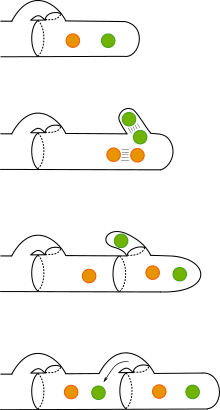Buckle (mycology)
Buckles are hump-shaped growths over the septa (transverse walls) of the hyphae of most mushrooms . Buckled hyphae are also known as nodular septate . Buckles are less well at the askogenen hyphae fruiting sac fungi exist, but there usually referred to as a hook. As the development of the dikaryotic mycelium , buckles help to maintain the binuclear structure and ensure that during mitosis of a cell with cell nucleus A and B, both doubled cell nuclei A 'and B' can be found in the new cell.
Only the terminal cells of a hypha double. The cell first elongates until the cell nuclei have doubled (A 'and B' as newly created nuclei) and the cell has formed a protuberance, which will later become the buckle. A 'and B' travel to the end of the cell, while B is transported into the buckle and A to the other end of the cell, near the other hyphae cells, with the help of the cytoskeleton . The buckle forms a cell wall that separates B from the cell and shortly thereafter establishes a connection with the same cell, but closer to cell nucleus A. B can now migrate close to cell nucleus A and a septum forms between the two newly created hyphae cells , both of which are now dikaryotic again with a compatible pair of nuclei.
Usually only one buckle is formed per septum. But there are also types in which one can find two or more buckles on the septa. Such buckles are referred to as opposite or whorled (verticillate) buckles.

